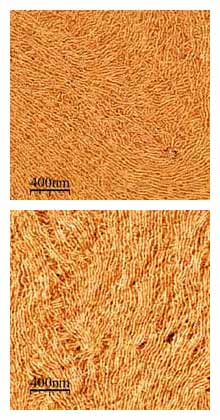Plastic Transistors for Flexible Displays
Transistors made of organic polymers can be used to make flexible displays using simple printing techniques. But one of the best-performing types of conductive polymer has been difficult to use in flexible displays because it is brittle and difficult to print. Now researchers at Carnegie Mellon University in Pittsburgh have demonstrated that this material can be combined with another common polymer currently used to make Plexiglas and sunglasses. The technique makes it more resilient and easier to manufacture and use in devices, without sacrificing its electronic properties.

In the past, combining two such polymers decreased electronic performance, since the conductive polymer was diluted. But the researchers found a way to combine the conductive polymer, called polythiophene, with the flexible one, called polymethylacrylate, so that even if only half as much polythiophene is used, the resulting material has about the same electronic properties as the conductive polymer alone.
To do this, Richard McCullough, a professor of chemistry, and Geneviève Sauvé, a postdoctoral associate, selected polymer subunits whose chemical and physical properties ensure that they combine in certain ways. They also pretreated the surface the polymers were applied to. As a result, the materials form a well-ordered structure that has an improved interface with the substrate (compared to the polymers on an untreated surface).
Indeed, Tim Swager, a professor of chemistry at MIT, says they achieved near-record performance for organic materials, even though they made the materials in air rather than in the rarefied conditions usually required to achieve the best results. That could simplify manufacturing and make it easier to incorporate the material into new products. (Swager is a scientific advisor to Plextronics, a Pittsburgh company that has licensed technology from McCullough.)
The material is also resilient, Swager says. If it is bent or otherwise strained, thus deranging the polymers, they will naturally return to their ordered state. That makes the material easier to manufacture and appealing for use in products that could be subject to strain, such as roll-up displays and solar cells.
In their experiments, the CMU researchers dissolve a type of polythiophene (a well-studied electrically conductive polymer) and polymethylacrylate (a common industrial polymer) in solution. They then deposit this solution on top of transistor electrodes and controlling gates. In the future, the polymers could be deposited in patterns using ink-jet or similar technology. As the solvent evaporates, the polymers form a thin film containing distinct alternating strands of flexible and crystalline polymer. The film serves as a semiconducting material for the channel in a transistor.
The researchers plan to use their technique to combine polythiophenes with other materials. Although the current material has high enough performance for applications such as e-books, where the screen refreshes relatively slowly, new combinations could lead to faster performance, perhaps suitable for displaying video. The material could be commercialized through Plextronics, where McCullough is chief scientist.
Keep Reading
Most Popular
Large language models can do jaw-dropping things. But nobody knows exactly why.
And that's a problem. Figuring it out is one of the biggest scientific puzzles of our time and a crucial step towards controlling more powerful future models.
The problem with plug-in hybrids? Their drivers.
Plug-in hybrids are often sold as a transition to EVs, but new data from Europe shows we’re still underestimating the emissions they produce.
Google DeepMind’s new generative model makes Super Mario–like games from scratch
Genie learns how to control games by watching hours and hours of video. It could help train next-gen robots too.
How scientists traced a mysterious covid case back to six toilets
When wastewater surveillance turns into a hunt for a single infected individual, the ethics get tricky.
Stay connected
Get the latest updates from
MIT Technology Review
Discover special offers, top stories, upcoming events, and more.